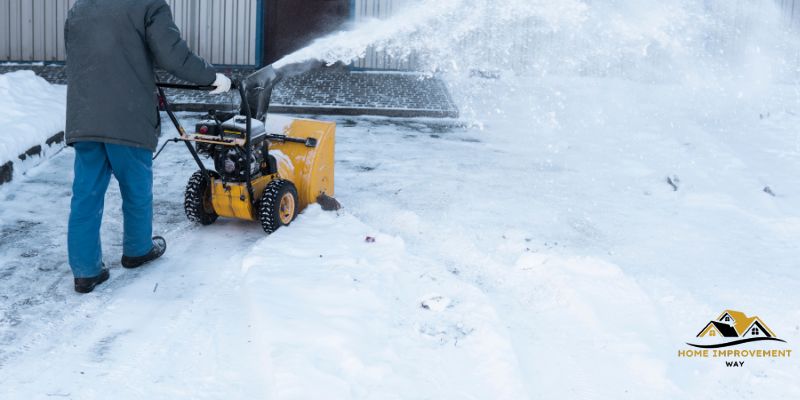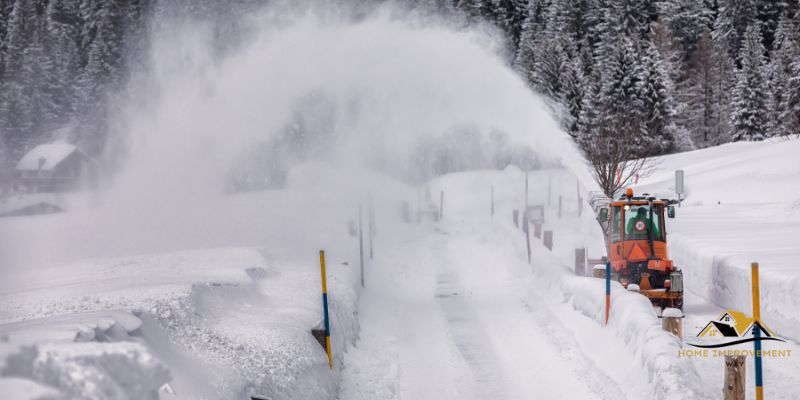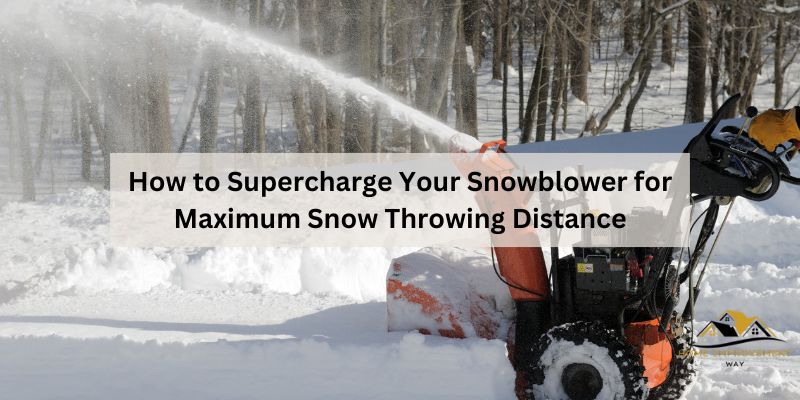To make your snowblower throw snow farther, adjust the chute deflector and angle, ensure the auger blades are sharp, and increase the engine speed to improve the snow-throwing distance. A snowblower is an essential tool to efficiently clear snow from your property during the winter season.
However, if you find that your snowblower isn’t throwing snow as far as you’d like, there are several simple steps you can take to improve its performance. By adjusting the chute deflector and angle, sharpening the auger blades, and increasing the engine speed, you can significantly increase the distance at which your snowblower throws snow.
We will explore these effective techniques to help you enhance the snow-throwing capabilities of your snowblower and make quick work of those snow-covered driveways and walkways.
Choosing The Right Snowblower
When it comes to optimizing your snowblower’s performance, choosing the right machine is essential. The right snowblower can make a world of difference when it comes to how far it can throw snow. Here are a few key factors to consider when selecting a snowblower for maximum snow-throwing distance:
Consider The Size And Power
Size and power are two crucial factors that determine how far your snowblower can throw snow. The bigger the snowblower, the more powerful it typically is, allowing for greater throwing distance. Look for models with high engine horsepower, such as 8 to 14 horsepower, to ensure the necessary power for throwing snow long distances.
Additionally, pay attention to the size of the intake chute. A wider intake chute can handle larger volumes of snow, increasing the throwing distance. Look for snowblowers with intake chutes that measure at least 20 inches wide.

Look For Adjustable Chute And Deflector
An adjustable chute and deflector are two features that can significantly impact the throwing distance of your snowblower. These options allow you to control the direction and angle at which the snow is thrown, maximizing the distance it travels.
Opt for snowblowers with a 180-degree rotating chute, which allows you to adjust the direction of the snow discharge easily. A deflector control lets you change the angle at which the snow is thrown, enabling you to achieve greater throwing distance. Look for snowblowers that offer both horizontal and vertical adjustment options.
Remember to consider the material and construction of these components as well. Look for durable materials like stainless steel or heavy-duty plastic that can withstand harsh conditions and frequent adjustments.
By keeping these factors in mind when choosing a snowblower, you can ensure that you select a machine capable of throwing snow as far as possible. Now let’s move on to other tips and techniques that can further enhance your snow-throwing distance.
Maintenance And Preparation
Maintenance and preparation are essential steps to ensure that your snowblower is working at its optimal level and throwing snow farther. By regularly checking and maintaining key components of your snowblower, you can enhance its performance and efficiency. In this section, we will discuss three crucial areas of maintenance and preparation that you should focus on checking the oil and fuel levels, inspecting and sharpening the blades, and cleaning the chute and auger.
Check The Oil And Fuel Levels
Regularly checking the oil and fuel levels in your snowblower is vital to ensure proper functioning and maximum performance. Here are some steps to follow:
- Start by locating the oil dipstick, usually positioned near the engine.
- Remove the dipstick and wipe it clean with a cloth or paper towel.
- Insert the dipstick back into the oil reservoir, making sure it is fully inserted.
- Remove the dipstick once again and check the oil level.
- If the oil level is below the recommended range, add the appropriate amount of oil. Refer to your snowblower’s user manual for specific instructions on oil type and volume.
- Next, ensure that the fuel tank is adequately filled with clean gasoline. Check for any signs of impurities or water in the fuel, as these can impact the performance of your snowblower.
Inspect And Sharpen The Blades
The blades of your snowblower play a crucial role in effectively throwing the snow. Regular inspection and sharpening of the blades will help maintain their cutting efficiency. Here’s how you can do it:
- Carefully disconnect the spark plug wire to ensure that the snowblower is not accidentally started during blade maintenance.
- Inspect the blades for any signs of wear, damage, or dullness.
- If the blades are dull, remove them one at a time by unscrewing the bolts or fasteners.
- Using a sharpening tool or file, gently sharpen the edges of the blade. Be sure to follow the manufacturer’s recommendations for the appropriate sharpening technique.
- Once the blades are sharpened, securely reattach them to the snowblower.
Clean The Chute And Auger
The chute and auger of your snowblower can become clogged with snow, ice, or debris, reducing its throwing distance. Regular cleaning of these components will enhance the snowblower’s performance. Follow these steps:
- Switch off the snowblower engine and remove the key, ensuring that it is in a safe and secure position.
- Using a sturdy brush or tool, carefully remove any built-up snow, ice, or debris from the chute and auger.
- Inspect the chute and auger for any signs of damage or blockages that may hinder the throwing process.
- If necessary, use a lubricant spray to prevent any sticking or freezing of the chute and auger during operation.
By regularly performing these maintenance tasks and thoroughly preparing your snowblower before each use, you can ensure that it throws snow farther and operates at its peak performance. Remember, a well-maintained snowblower will keep your driveway clear and help you tackle even the heaviest snowfalls with ease!
Improving Power And Performance
Increase the throwing distance of your snowblower with these tips for improved power and performance. Discover techniques to enhance its efficiency and make clearing snow easier.
Improving the power and performance of your snowblower can significantly enhance its ability to throw snow farther. By optimizing its engine, impeller, auger belt, and other key components, you can ensure that your snowblower operates at its peak efficiency. In this section, we will discuss three effective ways to achieve this: upgrading to a higher horsepower engine, installing a larger impeller, and replacing the auger belt. Additionally, we will explore the importance of adjusting the skids and scraper bar to maximize snowblower performance.
Upgrade To A Higher Horsepower Engine
One of the most impactful ways to improve the throwing distance of your snowblower is by upgrading to a higher horsepower engine. A more powerful engine allows the snowblower to effortlessly handle heavier and deeper snow, resulting in increased throwing distance. When considering an engine upgrade, it is crucial to select one that is compatible with your snowblower model. Consult the manufacturer’s guidelines or consult with an expert to ensure a proper fit.
Install A Larger Impeller
Another effective method to boost performance is by installing a larger impeller. The impeller is responsible for propelling snow through the chute, and a larger impeller can generate more force to throw snow farther. Before purchasing a new impeller, review your snowblower’s specifications to determine the appropriate size and design.
Replace The Auger Belt
The auger belt plays a pivotal role in transferring power from the engine to the impeller. Over time, the belt can wear out, leading to reduced performance. By regularly inspecting and replacing the auger belt when necessary, you can ensure optimal power transmission and improve snow-throwing capabilities. Refer to your snowblower’s manual or consult a professional for guidance on the correct replacement belt for your model.
Adjust The Skids And Scraper Bar
When it comes to maximizing the throwing distance, the proper adjustment of the skids and scraper bar is crucial. The skids help control the height at which the snowblower operates, while the scraper bar ensures an efficient cleaning of the surface. Adjusting the skids and scraper bar optimizes the snowblower’s contact with the ground, allowing for a smoother operation and enhanced throwing distance. Follow the manufacturer’s instructions or seek expert advice to achieve the correct adjustment suitable for your specific snowblower model.
In conclusion, improving the power and performance of your snowblower can greatly increase its snow-throwing capabilities. By upgrading to a higher horsepower engine, installing a larger impeller, replacing the auger belt, and adjusting the skids and scraper bar, you can ensure that your snowblower throws snow farther and tackles even the toughest winter conditions with ease.

Optimizing Snow Throwing Distance
When winter arrives and the snow starts piling up, having a snowblower that can throw snow farther can make your snow removal tasks much easier and more efficient. Luckily, there are a few simple steps you can take to optimize the snow-throwing distance of your snowblower. By adjusting the chute direction and angle, clearing the snow in layers, keeping a steady pace, and avoiding wet and heavy snow, you can improve the performance of your snowblower and make those snowy days a breeze.
Adjust The Chute Direction And Angle
One of the key factors that determines how far your snowblower can throw snow is the direction and angle of the chute. To optimize the snow-throwing distance, ensure that the chute is properly adjusted. Start by pointing the chute in the direction you want the snow to be thrown. This is typically away from areas you have already cleared and towards open spaces. Adjust the angle of the chute to a higher position to increase the distance the snow travels. Experiment with different angles to find the optimal setting for your snowblower.
Clear The Snow In Layers
Clearing the snow in layers is another effective way to maximize the throwing distance of your snowblower. Instead of trying to clear a large amount of snow in one pass, divide the area into smaller sections and tackle them one at a time. By clearing the snow in layers, you allow the snowblower to throw the snow farther with less strain on the machine. This technique also helps in preventing clogging, especially when dealing with heavy and wet snow.
Keep A Steady Pace
Maintaining a steady pace while operating your snowblower can significantly impact the throwing distance. Avoid rushing or going too fast, as this can cause the snow to pile up in front of the machine, reducing the throwing distance. On the other hand, going too slow can also hinder the snowblower’s performance. Find a comfortable speed that allows the snow to be picked up and thrown efficiently. Keep a consistent pace throughout your snow removal task to ensure optimal performance and maximum snow-throwing distance.
Avoid Wet And Heavy Snow
When it comes to maximizing the snow-throwing distance of your snowblower, avoiding wet and heavy snow is crucial. Wet and heavy snow can clog the chute and impeller, hindering the snowblower’s ability to throw snow far. It’s always best to tackle snow removal when the snow is fresh and powdery. If you must clear wet and heavy snow, take smaller sections at a time and adjust the chute and angle accordingly to compensate for the increased weight.
Safety Tips And Best Practices
Snowblowers are powerful machines designed to handle heavy snowfall and clear pathways efficiently. However, it’s important to prioritize safety while operating these machines. By following a few key safety tips and best practices, you can ensure both your own safety and the effective functioning of your snowblower.
Wear Protective Clothing
Before you start using your snowblower, make sure you are dressed in appropriate protective clothing. This includes:
- Insulated and waterproof boots to keep your feet warm and dry.
- Warm and layered clothing to protect your body from cold temperatures.
- Goggles or safety glasses to shield your eyes from flying snow, debris, and ice.
- Gloves to keep your hands warm and provide a firm grip on the machine.
- Hearing protection such as earplugs or earmuffs to safeguard your hearing from the noise of the snowblower engine.
Keep The Area Clear Of Obstacles
One of the crucial safety measures when using a snowblower is ensuring the area you are clearing is free from obstacles. Before you begin, inspect the area and remove any potential hazards, such as rocks, branches, or toys. Clearing the pathway beforehand will prevent any damage to your snowblower and minimize the risk of accidents during operation.
Be Cautious Around Moving Parts
While operating a snowblower, it’s essential to exercise caution around its moving parts. These machines have rapidly rotating blades and augers that can cause severe injuries if mishandled. Follow these guidelines to stay safe:
- Avoid placing your hands or feet near the discharge chute while the snowblower is running.
- Never try to clear a clog or remove debris from the machine without first turning it off and disconnecting the spark plug.
- Do not operate the snowblower on uneven or slippery surfaces to prevent any loss of control and potential accidents.
Follow the Manufacturer’s Instructions
To ensure your safety and the optimal performance of your snowblower, it is crucial to follow the manufacturer’s instructions. These guidelines may include:
- Proper starting and shutting down procedures specific to your snowblower model.
- Recommended maintenance and cleaning schedules to keep your snowblower in peak condition.
- Safe operation practices tailored to your particular machine.
By adhering to the manufacturer’s instructions, you can use your snowblower efficiently and minimize the risk of accidents.
Conclusion
Maximizing the distance your snowblower throws snow requires a combination of proper maintenance and effective technique. Regularly maintaining your snowblower, including checking the auger and impeller, adjusting the chute, and using the right speed and direction, can greatly improve its throwing distance.
Additionally, using dry snow and avoiding wet or icy conditions can help achieve better results. By implementing these tips, you can enhance the performance of your snowblower and make the task of clearing snow much easier and more efficient.


